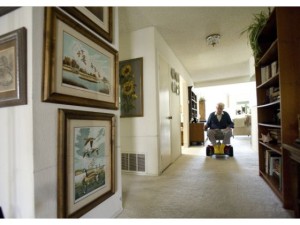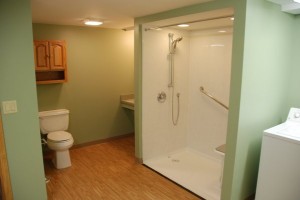
Dee J. Valentine, 100, glides through his Mission Viejo home of 32 years. About a month after he entered hospice, 200 friends and family gathered to celebrate his 100 years of life. CINDY YAMANAKA, THE ORANGE COUNTY REGISTER
Home is where nine out of 10 Americans wish to live out their last years, months and days according to the AARP. Recently, I spent the day with Dee J. Valentine, a 100-year-old man, living independently in his Mission Viejo home of 32 years. Valentine is a poster child for this growing movement and awareness called Aging in Place retooling how we can live at home in life’s final chapter instead of a nursing home or some other institutionalized setting.
“With a few modifications people have been able to stay in their home and this is good for their dignity, for their soul their mind because they are surrounded by everything they love and are familiar with,” Leslie Gibola, an occupational therapist and owner of Adapt 2 It ,a community store that sells home health equipment in Orange County, California.
“I am one that believes that houses have feelings,” she said. “If you been there 50 years you love the house and the house loves you.”
I’ve spoken to experts in this movement to help us visualize what we can do to adapt our homes to make these last wishes come true for those we love and ourselves. Aging in Place means living safely and comfortably in your home as long as you wish regardless of age or ability, experts say.
When I arrived at Valentine’s home, he was getting his morning exercise strolling on his walker around his house under the watchful eye of Maribel Cruz, an aide from Hospice Care of the West, a local Orange County hospice. I visited him for interview while working on a column for the Orange County Register about how he celebrated his 100-year birthday with 200 of his family and friends.
Before my visit, he’d been engaged in his normal a.m. routine making his own breakfast then sitting down for a couple hours to read the newspaper and do his crossword puzzles. Cruz helped him bath and get ready for the day. His home health aide helps maintain his dignity so he doesn’t have to rely on his daughter to help him with his daily maintenance. After his exercises, she left. He has a medical alert bracelet that enables him to call for emergency help in the case of a fall or other situation like heart failure occurs.
He easily transfers onto his electronic scooter so he could glide around the house. He’s swift using a joystick to reverse and maneuver forward with ease around corners, into the living room, down halls, into the kitchen and the bathroom. He’s an excellent driver on the scooter. About an hour later, Gina Mendoza, his nurse arrived from Hospice Care of the West, to dress the wounds on his legs and check his vitals. He’s not able to walk due to circulation issues in his legs.
He joined Hospice Care of the West, a local Orange County hospice, because he can receive the care and support he needs in his home so that he doesn’t have move to an assisted living facility.
“I don’t want to live in a board in care,” Valentine said. “I can fix my own breakfast, warm up stuff for lunch.”
At lunchtime, he makes himself some cheese, salami and crackers. Everything in the kitchen is at the level on his scooter so the cheese and salami were in a refrigerator drawer and crackers in a cupboard within reach. He sat on scooter and ate on the kitchen table.
Valentine and his daughter, Michele Miller, talked about his end of life plans, he didn’t want any extraordinary measures and wanted to live out his last days at home. So, she moved in with him and her daughter is now living in her home. Miller has helped Valentine adapt his home so that he could age in place.
Adapting the Home to Age in Place
I spent some time with folks involved in this Aging in Place movement to help visualize and realize how to age gracefully and independently with dignity at home. I chatted with Mike Dodd, President of Lifewise Renovations www.lifewiserenovations.com, focused on modifying the home.
“The boomer generation with an eye toward the future is looking at their aging parents and realizing that we’ll be there in a blink of an eye,” said Dodd, a boomer himself at age 58 and an aging in place residential remodel contractor. So, he changed the focus of his residential remodeling business to meet the needs of our aging folks. He has occupational therapists on his team to help tailor the modifications to a person’s specific needs. An occupational therapist for those unfamiliar is trained in creating solutions to help the disabled become physically able to perform the tasks of daily living. Dodd talks about the reasons we wish to stay in our home.
- Maintaining a sense of independence in a comfortable environment
- Feeling the security of familiar surroundings
- Enjoying a home that has been tailored to your specific needs
Gibola, an occupational therapist and owner of Adapt 2 It, says the idea of aging in place is making plans to turn your home into a safe place to live in your last years, while also preventing crisis due to a fall that will land you in a nursing home. Giobla, took me on a virtual walk-through of her home evaluations. She will visit the home to assess risk and mobility. Upon arrival she will look at steps and or porch to get into the home. She checks out flooring, carpeting and throw rugs in an effort to assess the danger of falls and mobility access in a wheel chair. She’s examines lighting and cabinetry throughout the house to figure out easy access to necessary household items.
Gibola says that if you can imagine something you need
for assistance to stay in your home she confidently believes there is a solution for you. She says changes don’t have be huge in terms of time and investment, or disturb the décor of the home. Especially investment, as she said, most assisted living facilities are upward of $5,000 a month. She can modify a home with a ramp into the home, stair chairlift and modifications to the doorways and bathrooms to be less than four months of stay in an assisted living facility. I should point out that $5,000 is on the high end of assisted living monthly costs because she is in California where cost of living is higher. She can adapt the home without turning it into a quasi-hospital environment.
She makes all the deliveries of the equipment to the home herself and then stays through installation. Gibola says it’s phenomenally rewarding to provide people with mobility and access in their homes where it was previously absent. It feels like a miracle when she enables them to use the equipment that returns freedom and independence to their lives.
Gibola is a member of the National Aging In Place Council that is focused on advocacy and education while also providing a resource for communities to connect to the professionals who can help make aging in place a reality. Just to name a few of these professionals:
- Occupational Therapists
- Physical Therapists
- Residential Remodel Contractors
- House Doctors—make house calls
- House Dentists—make house visits
- Home Health Care Providers
- Hospice Care Providers
- In-Home Catering Services
Renovating the Home
Dodd says with his help and others like him that follow the universal design solutions, you can stay at home until your last breath. When I asked him how many times he needed to come back into the home to adjust to one’s deteriorating condition, he said none.
place is the bathroom. This is one of the bathrooms he modified with a curb-less walk-in showers.Courtesy of Mike Dodd/Lifewise Renovations
If he had to return then he didn’t do his job right the first time. In the 15 years he’s been doing this he’s never had to go back.
Some basic aging in place solutions that Dodd recommends:
- Installing grab bars at bath areas
- Replacing toggle-style electrical switches with rocker-style switches
- Installing roll-out drawers at kitchen base cabinets for easier access
- Changing the volume and frequency of doorbells and telephones
- Installing single lever plumbing fixtures
He cautions against DIYer sons or nephews to perform these tasks because if these safety modifications are installed incorrectly, the result could be hazardous and potentially disastrous. Poor installation could mean pulling them out of the wall leading to a nasty fall.
Examples of his more advanced remodeling suggestions are:
- Installing curb-less walk-in showers
- Installing additional lighting in kitchen, hallways, staircases and outside walkways
- Widening doorframes to accommodate wheelchairs and walkers
- Installing height-adjustable countertops in the kitchen and bathroom
- Changing the color of countertops to distinguish the edge from the floor
- Installing ramps and elevators
Click here to read the story about a couple who chose to remodel their home so they wouldn’t have to move into assisted living facility once they could no longer perform their everyday living tasks. They did all their research and figured out this was the most cost effective solution to making their wish of staying at home a reality.
Care in the Home
Once you’ve adapted your home like Valentine then home care options must be evaluated for your long-term plan. Debbie Robson, Executive Director at Hospice Care of the West, suggested that the best way to have what she calls “self-determined life closure” is first to find out the wishes of her patients. “Where do you want to spend your last days?” Due to poor planning, or a medical crisis the elderly end up cycling in and out of institutionalized settings such as the hospital, for acute care, a rehabilitation facility or an assisted living facility for nursing care. Going back home is the paramount wish I hear most often when I spend time with seniors living in institutionalized settings.
“Hospice and Home Health is the best choice for a person to have a safety net of support to stay home as long as possible,” Robson said.
Home health care is a service that provides skilled nursing care in the home. Hospice is an interdisciplinary team of medical professionals to help you live at home with a life-limiting illness of six months or less prognosis. The team consists of a physician, nurse, social worker, spiritual care coordinator, home health aide and a volunteer to care for you with scheduled visits in the home.
Adapting the home and selecting the right kind of care will ensure your loved one’s last wishes or yours to live independently at home like Valentine to age 100 and beyond.


I would love to spend my last years living in my own home, and hope that I will be in a position to do so. One of the things I will definitely invest in is a medical alarm or alert system – they’re truly one of the better inventions of the last century! Being able to stay independent, not have to rely on 100% care or always having someone around, is the biggest advantage of these systems.
Do you people have a facebook fan page? I looked for one on twitter but could not discover one, I would really like to become a fan!
Post author
We’re working on a Facebook page! We’ll keep you updated when it’s live.